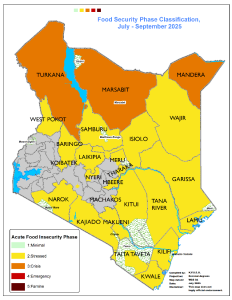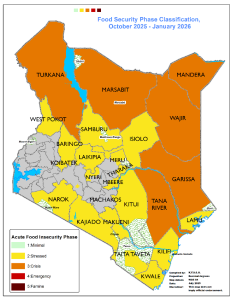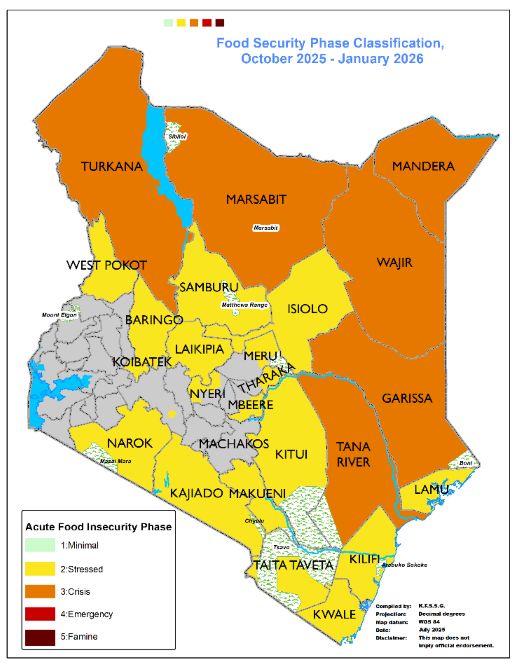The assessment of the 2025 long rains season indicates that food security has remained relatively stable across most ASAL counties, supported by the near-average to above-average performance of the rains. However, an estimated 1.76 million people are currently in urgent need of food assistance, a figure projected to rise to 2.12 million by January 2026.
Three counties, Turkana, Marsabit, and Mandera, are classified in Crisis Phase (IPC Phase 3) of the Integrated Food Security Phase Classification. The remaining 20 counties are in Stressed Phase (IPC Phase 2): Garissa, Tana River, Isiolo, Samburu, Baringo, Kitui, Kajiado, Makueni, Laikipia, Meru North, Wajir, Lamu, Embu, Tharaka, Kilifi, Kwale, Nyeri, West Pokot, Narok, and Taita Taveta.
Acute malnutrition remains a serious concern. High levels were recorded in Turkana, Marsabit, Wajir, Garissa, and Mandera, with Baringo North specifically classified in Critical Acute Malnutrition (IPC Phase 4). In total, about 741,883 children under five years and 109,462 pregnant and lactating women are acutely malnourished and in urgent need of treatment.
Figure 1: Current and projected food security situation


The prevailing stability is largely attributed to the better-than-anticipated performance of the March to May long rains, which exceeded earlier forecasts of below-normal rainfall.
The 2025 Long Rains Food and Nutrition Security Assessment was conducted between 15th July and 7th August 2025. It was coordinated by the Kenya Food Security Steering Group (KFSSG), a multi-agency platform comprising Government departments, UN agencies, and non-governmental organisations, working in collaboration with County Steering Groups.
Food security in Kenya is highly dependent on rainfall. Given the bimodal rainfall pattern in the ASALs, assessments are carried out twice a year, following the October to December short rains and the March to May long rains. The 2025 assessment focused on the 23 ASAL counties, which are the most food-insecure due to high poverty levels, vulnerability to shocks and hazards, aridity, and high rainfall variability.
The assessment sought to determine the impact of the 2025 long rains on food and nutrition security, taking into account cumulative seasonal effects and other shocks affecting food availability, access, utilisation, and stability. The report also analyses contributing factors and outcomes, highlighting their implications for key sectors, including water, livestock, agriculture, health and nutrition, education, peace and security, and markets and trade. It further provides recommendations for targeted interventions.
The analysis applied the Acute Integrated Food Security Phase Classification (IPC Version 3.1) to determine the severity and underlying causes of food insecurity. In addition, the IPC Acute Malnutrition analysis was used to identify both food and non-food drivers of malnutrition. The IPC is an internationally recognised standard that ensures adherence to global best practices in classifying food insecurity severity.
Full Report: 2025 Long Rains Food and Nutrition Security Assessment Report
IPC Report: IPC Kenya Acute Food Insecurity Acute Malnutrition July 2025 – January 2026 Report

